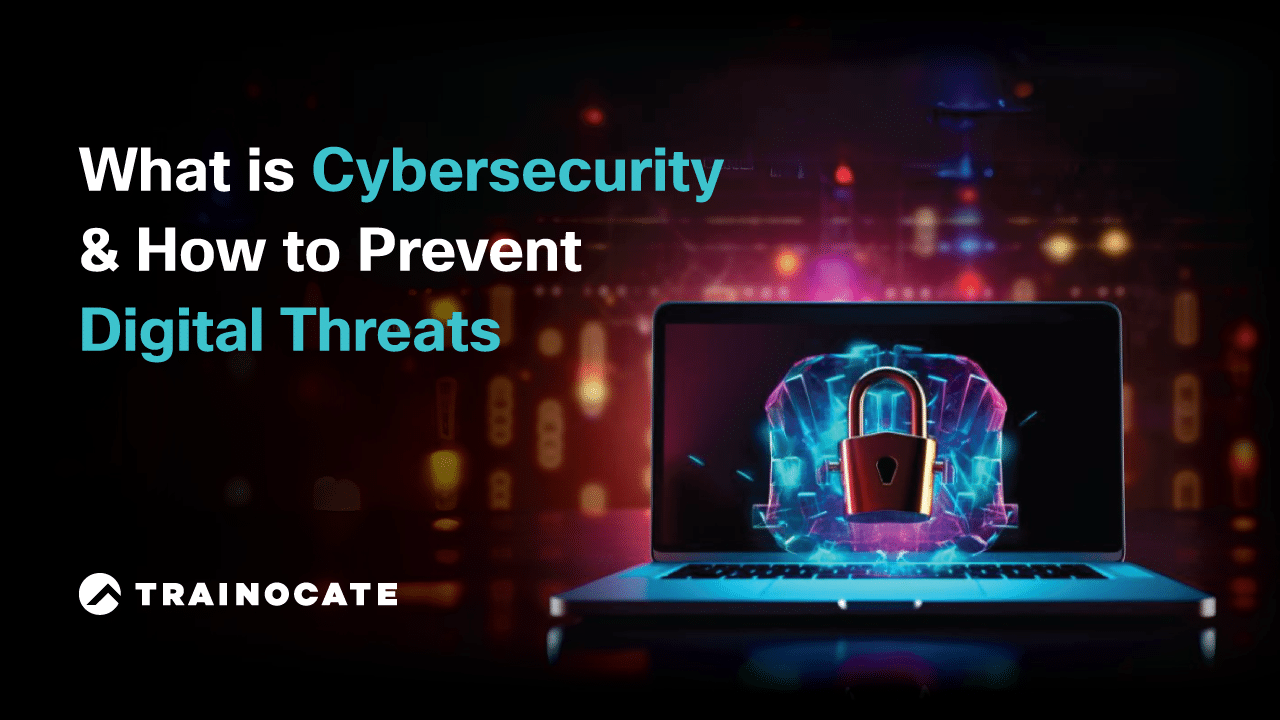What is Cybersecurity and How to Prevent Digital Threats
What is Cybersecurity and How to Prevent Digital Threats

___
What is Cybersecurity?
Remember the time you clicked on a suspicious email link and suddenly, your computer froze? You were the victim of a cyber attack. This experience, while distressing, is a stark reminder of the importance of understanding what is cybersecurity.
___
Key Takeaways
- Cybersecurity is a combination of technology, processes, and people to protect digital assets from cyber threats.
- Cybercrime costs the world an estimated $10.5 trillion annually by 2025. Organizations must protect themselves against fines & reputational damage as well as essential services such as power grids & water treatment facilities.
- Effective cybersecurity requires training in security awareness, implementation of policies/standard/procedures/guidelines plus regular system and application updates. Formal employee training for security professionals plays a vital role in protecting digital systems and resources.
___
Cybersecurity
Consider cybersecurity as a fortress. This fortress, made up of technology, processes, and people, helps safeguard your digital treasures—your data—from cyber pirates. Like castle walls, security solutions protect internet resources and computer systems, which are like the castle’s treasury, holding valuable information.
However, the resilience of any fortress, no matter how strong, is determined by its weakest point —human. Cybersecurity is not just about having the right tools, but also about keeping them up-to-date and ensuring that everyone knows how to use them properly. It’s a team effort, involving everyone from:
- the king (the business owner)
- the queen (the IT department)
- the knights (security professionals)
- the foot soldiers (employees)
___
The Growing Importance of Cybersecurity
The world is becoming increasingly interconnected, and with this connection comes increased security risks. Cybersecurity is a shield that helps maintain our modern standards of living by mitigating these risks and protecting valuable digital assets. However, the scale of the threat is immense. Imagine a city under siege, with the enemy (cybercrime) expected to cost the world $10.5 trillion a year by 2025. If a city falls, the costs are high—infrastructure is destroyed, citizens are harmed, and the city’s reputation suffers. The aftermath of a cyber security breach is similar. Organizations may face substantial fines and reputational damage.
Without adequate cyber security resources and defenses, even modern-day essentials like power grids and water treatment facilities could be compromised.
___
Common Cyber Threats and Attacks
Just as there are different siege tactics in warfare, such as battering rams or catapults, cyber attackers also employ various tactics. Types of cyber threats, including cyber attacks, are often categorized as:
- Malware
- Ransomware
- Phishing
- Social engineering

1. Malware and Viruses
Malware, the digital equivalent of a battering ram, is a type of malicious software designed to inflict harm. It comes in many forms, including ransomware, spyware, adware, trojans, worms, viruses, and rootkits. To protect your system from these threats, it’s essential to use antivirus software.
The computer virus, a type of malware, operates similarly to a biological virus. Like a wolf in sheep’s clothing, it infiltrates programs and files with malicious code. Once inside, it can alter the computer’s functioning and propagate to other systems, causing damage or gaining control of the device.
Some of the most destructive viruses in history include:
These viruses have caused billions of dollars in losses.
2. Ransomware Attacks
Contrarily, ransomware attacks mirror castle sieges that restrict access to the castle (the network) until a ransom is fulfilled. These attacks can be disseminated through phishing emails, malicious downloads, or by exploiting vulnerabilities in software.
The repercussions of a ransomware attack can be extensive. Similar to a prolonged siege, it can result in:
- Financial losses
- Operational disruptions
- Damage to reputation
- Loss of sensitive data
In recent years, the frequency of ransomware attacks and data breaches has increased, with ransomware accounting for approximately 20% of cyber breaches in 2022.
3. Phishing and Social Engineering
Phishing and social engineering attacks are akin to Trojan horses. Attackers trick individuals into revealing personal information or granting unauthorized access to systems. Phishing, a type of social engineering attack, deceives users with false messages to induce them to install malicious files, click on hazardous links, or reveal confidential information.
There are several types of phishing attacks, including email phishing, spear phishing, whaling, smishing and vishing, and angler phishing. Social engineering attacks employ broader tactics, including phishing, spear phishing, baiting, malware, pretexting, quid pro quo, tailgating, vishing, watering hole, and cache poisoning or DNS spoofing.
___
Essential Components of Cybersecurity
In the world of cybersecurity, the fortress (cybersecurity plan) is made up of three essential components: people, processes, and technology.
1. People
People are integral to cybersecurity. Similar to a fortress whose strength is dictated by the vigilance and skill of its defenders, cybersecurity depends on the individuals’ awareness and training. Regular security awareness training is essential to equip staff with the necessary knowledge to address threats and apply best-practice advice to real-world situations.
People also play various roles in maintaining cybersecurity, including roles like a Computer Forensic Analyst, IT Security Specialist, Security Manager, and Security Engineer. Ongoing cybersecurity training is critical to heighten awareness of cybersecurity threats, fortify the organization’s digital network, safeguard digital assets and data, and preserve the organization’s reputation and financial well-being.
2. Processes
Processes in cybersecurity are like the rules and regulations in a fortress. They involve the implementation of policies, procedures, and guidelines to ensure consistent and effective security measures.
Some examples of these processes include:
- Privileged password management
- Network security audit workflow
- Firewall audit workflow
- VPN configuration
- Identifying physical and software assets within an organization and establishing asset management protocols.
The implementation of security processes in an organization involves numerous steps. These encompass:
- Assessing and evaluating IT assets
- Risk assessment
- Setting up security objectives
- Selecting security controls
- Documenting the security plan
- Implementing the security processes
3. Technology
Technology in cybersecurity includes:
- Firewalls
- Intrusion detection systems
- Virtual private networks
- Encryption
- Two-factor authentication
These tools and systems, known as cyber security solutions, are used to detect, prevent, and respond to cyber threats.
Take the role of a firewall, for instance. Like a castle’s drawbridge, it provides a barrier between secure internal networks and untrusted external networks. It inspects and filters incoming and outgoing network traffic, allowing only authorized traffic to pass through and blocking malicious traffic.
___
Cybersecurity Best Practices
As a fortress necessitates a maintenance routine to retain its strength, cybersecurity calls for routine upkeep. Best practices encompass regular software updates, secure password management, and employee training.
Think of software updates as regular fortress inspections, patching up any cracks in the wall to prevent invaders from breaking through. Secure password management is akin to changing the locks on the fortress gates regularly, and employee training ensures that each guard knows their role and how to respond to threats effectively.
___
The Role of Cybersecurity Professionals
Cybersecurity professionals, akin to skilled knights in a medieval army, are highly sought after. They serve as the protectors, safeguarding devices and systems from malicious actors. Imagine a world under constant threat from invaders, and you’ll understand why there is a critical and increasing demand for these skilled warriors.
The cybersecurity sector offers a variety of job roles, including:
- Security roles
- Security consultants
- Data protection officers
- Cloud security architects
- SOC managers and analysts
- Security investigators
- Cryptographers
- Security administrators
Each role is essential in protecting the digital kingdom and ensuring the security of its people and resources.
___
Emerging Cybersecurity Trends and Challenges
The cybersecurity landscape resembles an ever-changing battlefield. The current developments involve increasing complexity of cyberattacks, the escalating amount of data to be safeguarded, and the broadening attack surface caused by the Internet of Things (IoT).
New threats have emerged, including:
- Advanced Persistent Threats (APTs)
- Ransomware attacks
- Internet of Things (IoT) attacks
- Cloud-based attacks
- Insider threats
Furthermore, the Internet of Things (IoT) has contributed significantly to the expansion of the cyber attack surface, like an ever-expanding battlefield introducing new fronts and challenges, especially with the increasing use of mobile devices.
___
Cybersecurity Courses & Certifications
For those motivated to become part of the cybersecurity professionals, numerous cybersecurity certifications and courses and are accessible. These offerings provide individuals with the requisite skills and credentials for a career in this rapidly growing field:

1. AWS-SEC: Security Engineering on AWS
This AWS course equips individuals with the skills to leverage AWS security services effectively within the AWS Cloud. Focused on best security practices recommended by AWS, it covers securing data and systems in the cloud.
Attendees will learn to utilize key AWS services such as compute, storage, networking, and databases, along with automation tools for continuous monitoring and incident response, preparing for the AWS Certified Security – Specialty certification.
| Course Code | Course Title | Training Duration | Training Mode |
|---|---|---|---|
| AWS-SEC | Security Engineering on AWS | 3 Days | Instructor-Led (Available in Virtual or Physical Sessions) |

2. CEH: Certified Ethical Hacker
This EC-Council‘s CEH certification offers comprehensive knowledge of cutting-edge hacking tools and methodologies used by hackers and security professionals for lawful penetration testing.
Widely recognized by global employers, it’s a critical credential for those aiming to understand and prevent cybersecurity threats in organizations.
| Course Code | Course Title | Training Duration | Training Mode |
|---|---|---|---|
| CEH | Certified Ethical Hacker v12 | 5 Days | Instructor-Led (Available in Virtual or Physical Sessions) |

3. CHFI: Computer Hacking Forensic Investigator
This EC-Council’s CHFI certification covers digital forensics analysis in today’s digital landscape, from detecting breaches to gathering evidence for legal proceedings.
With a focus on practical learning, it’s designed for professionals including forensic analysts, incident responders, security consultants, and more.
| Course Code | Course Title | Training Duration | Training Mode |
|---|---|---|---|
| CHFI | Computer Hacking Forensic Investigator | 5 Days | Instructor-Led (Available in Virtual or Physical Sessions) |

4. CISA: Certified Information Systems Auditor
This Isaca’s cybersecurity course covers all domains of the CISA exam, this course provides the necessary knowledge for obtaining the CISA certification, setting the gold standard for IS auditing, control, and security since 1978.
| Course Code | Course Title | Training Duration | Training Mode |
|---|---|---|---|
| CISA | Certified Information Systems Auditor | 5 Days | Instructor-Led (Available in Virtual or Physical Sessions) |

5. CISM: Certified Information Security Manager
Addressing contemporary security threats, this Isaca’s course teaches risk assessment, effective governance, and proactive incident response. The CISM certification enhances credibility and confidence when interacting with stakeholders and regulators.
| Course Code | Course Title | Training Duration | Training Mode |
|---|---|---|---|
| CISM | Certified Information Security Manager | 4 Days | Instructor-Led (Available in Virtual or Physical Sessions) |

6. CT-CYSA+: CompTIA Cybersecurity Analyst
Geared towards monitoring and responding to security incidents in information systems and networks, this CompTIA certification prepares individuals to handle cybersecurity risks, identify threats, collect intelligence, and manage incidents effectively.
| Course Code | Course Title | Training Duration | Training Mode |
|---|---|---|---|
| CT-CYSA+ | CompTIA Cybersecurity Analyst | 5 Days | Instructor-Led (Available in Virtual or Physical Sessions) |

7. CT-PENTEST+: CompTIA PenTest+
Focused on penetration testing and vulnerability assessment, this CompTIA certification equips cybersecurity professionals to plan, manage, and address weaknesses effectively.
It emphasizes offensive skills and practical application through simulated pen testing.
| Course Code | Course Title | Training Duration | Training Mode |
|---|---|---|---|
| CT-PENTEST+ | CompTIA PenTest+ | 5 Days | Instructor-Led (Available in Virtual or Physical Sessions) |

8. AZ-500T00: Microsoft Azure Security Technologies
Offering expertise in implementing security controls and maintaining security postures on Microsoft Azure, this course emphasizes multi-layered security controls and threat intelligence for a highly secure cloud foundation.
Want to learn more about this Microsoft Azure Security certification? Read on our blog here: Microsoft Certified: Azure Security Engineer Associate (The Guide for 2023)
| Course Code | Course Title | Training Duration | Training Mode |
|---|---|---|---|
| AZ-500T00 | Microsoft Azure Security Technologies | 4 Days | Instructor-Led (Available in Virtual or Physical Sessions) |

9. SC-200T00: Microsoft Security Operations Analyst
This Microsoft security course is designed for Security Operations professionals, teaching mitigation of cyber threats using Azure Sentinel and Kusto Query Language (KQL), preparing learners for the SC-200 exam.
This SC-200 training also serves as a prerequisite for cybersecurity architects who wish to earn the Microsoft Certified Cybersecurity Architect Expert certification.
| Course Code | Course Title | Training Duration | Training Mode |
|---|---|---|---|
| SC-200T00 | Microsoft Security Operations Analyst | 4 Days | Instructor-Led (Available in Virtual or Physical Sessions) |

10. RCCE1: Rocheston Certified Cybersecurity Engineer – Level 1
This Rocheston Cybersecurity course serves as an introduction to cybersecurity fundamentals, offering hands-on labs and insights into hacking technologies. Covering foundational aspects like web application attacks, malware, denial of service, and more, Level 1 acts as a prerequisite for progressing to the advanced Level 2 program.
It’s a Linux-based course emphasizing practical learning and essential knowledge for those entering the cybersecurity field.
| Course Code | Course Title | Training Duration | Training Mode |
|---|---|---|---|
| RCCE1 | Rocheston Certified Cybersecurity Engineer – Level 1 | 5 Days | Instructor-Led (Available in Virtual or Physical Sessions) |
___
Summary
In the ever-changing landscape of cyber threats, understanding the fundamentals of cybersecurity, its importance, and the role of people, processes, and technology is essential. Armed with this knowledge and following best practices, we can each play our part in maintaining the digital fortress and safeguarding our valuable data.
___
Frequently Asked Questions
1. What is cybersecurity in simple words?
Cybersecurity is the practice of protecting internet-connected devices, networks and systems from malicious attacks by hackers, spammers and cybercriminals. It is used to defend against phishing schemes, ransomware attacks, identity theft, data breaches and financial losses.
2. What exactly does cyber security do?
Cyber security safeguards networks, devices, programs, and data from attack, damage, or unauthorized access using a range of technologies, processes, and practices. It is also referred to as information technology security.
3. What are the 3 major types of cyber security?
The three major types of cyber security are network security, cloud security, and physical security. Network security involves operating systems and network architecture, such as network protocols, firewalls, wireless access points, hosts, and servers. Cloud security covers the hardware and software of cloud computing services, while physical security is concerned with securing physical devices like computers and mobile phones.
4. What are some of the more prevalent cyber threats?
Malware, ransomware, phishing, and social engineering are some of the more prevalent cyber threats faced by individuals and organizations alike.
5. What are the essential components of cybersecurity?
The essential components of cybersecurity are people, processes, and technology, all of which are necessary for protecting systems from malicious attacks.





